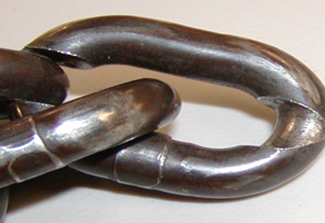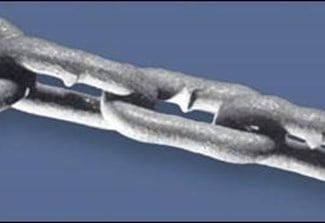Chain Sling Wear and Stretch: Are They the Same?
Rigging | Safety and Training | By Henry Brozyna | Jul 24, 2019
Frédéric, a mechanical engineer for the auxiliary equipment unit of a Canadian public utility company and recent safety webinar attendee, asked the following question about chain sling wear:
“You said a sling should be removed from service if it stretches. But, you also said that 10% of wear is permissible. Does this mean that a stretch of 5 to 10% should be ok, because wear will make the sling stretch (the reach will increase)?”
Henry Brozyna, CMCO trainer and safety webinar presenter, answers:
Chain sling wear and stretch are two different things and both will make the sling length increase. So, it is sometimes difficult to differentiate between the two.
Examples:
An example of unacceptable chain wear

An example of stretched/elongated chain

Wear will show itself at the bearing points of the links and can exhibit itself in the bearing points of the chain as a groove. A certain amount of wear is permissible and that will happen over time. Check with the manufacturer to see how much wear they allow.
Stretch or elongation are clear signs of overloading. As such, ASME B30.9 Slings lists stretched chain links or components as one of the reasons a chain sling shall be removed from service. The word “shall” in a standard resolves any doubt. No stretch or elongation is allowable.
Want to learn more? View our safety webinar:
Before using a chain sling, it is important to perform a pre-lift inspection to prevent accidents and injuries. In this webinar, we will identify rigging gear used in slings as well as terms associated with them. We will also discuss OSHA regulations and ASME standards that apply to your rigging equipment.
Henry Brozyna
Henry Brozyna is an Industry Product Trainer at Columbus McKinnon specializing in Crane and Hoist Inspection and Repair, Rigging & Load Securement He has been training on crane and rigging safety for more than 20 years. Henry is a member of the Tie Down committee and former Board of Directors for the WSTDA; this group writes the standards that are used by the material handling industry, the transportation industry, and also law enforcement. Henry is also a current member of the Crane Institute’s board of directors.

Related Articles
Understanding the Difference between Chain Grades and How They’re Used
A Guide to Graded Welded Chain | 3 Minute Read
Columbus McKinnon's Professional Training Team reviews the various chain grades and walks through examples of how they are used.



 North America - EN
North America - EN



